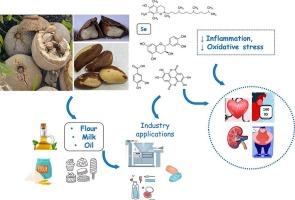Brazil nut (Bertholletia excelsa Bonpl.) in health and disease: A narrative review
IF 8.5
1区 农林科学
Q1 CHEMISTRY, APPLIED
引用次数: 0
Abstract
Brazil nut is one of the most consumed nut-producing species from South America. This narrative review evaluates the potential benefits of Brazil nut in health and disease. Various preclinical studies have shown that Brazil nut possesses antioxidant and anti-inflammatory actions and may be associated with antihypertensive, anti-nephrotoxic, cardioprotective (by reversing obesity, diabetes, hypertension, and dyslipidemia), and antineoplastic properties. Additionally, several clinical trials showed that Brazil nut can improve antioxidant defense, reduce inflammatory processes, attenuate glycemia, prevent obesity and hypertension, reduce visceral adiposity, reduce endothelial dysfunction, and improve vascular tone. Besides its various health benefits, Brazil nut can be a promising agent in the food industry for enhancing products with a better nutritional profile and meeting the growing demand for functional and sustainable foods. Moreover, secondary products derived from the Brazil nut, such as Brazil nut oil and phytocompounds, have potential for use in multiple pharmaceutical and cosmetics industries.

巴西坚果(Bertholletia excelsa Bonpl.)的健康与疾病:叙述性综述
本文章由计算机程序翻译,如有差异,请以英文原文为准。
求助全文
约1分钟内获得全文
求助全文
来源期刊

Food Chemistry
工程技术-食品科技
CiteScore
16.30
自引率
10.20%
发文量
3130
审稿时长
122 days
期刊介绍:
Food Chemistry publishes original research papers dealing with the advancement of the chemistry and biochemistry of foods or the analytical methods/ approach used. All papers should focus on the novelty of the research carried out.
 求助内容:
求助内容: 应助结果提醒方式:
应助结果提醒方式:


